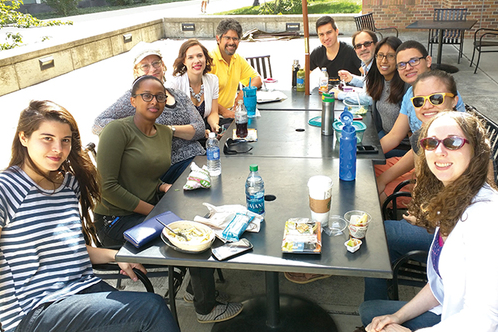This weekend, Lake Shore Cryotronics was highlighted in the Columbus Dispatch. CEM Director P. Chris Hammel was interviewed on the company’s importance in the scientific community.
Read the article here.

This weekend, Lake Shore Cryotronics was highlighted in the Columbus Dispatch. CEM Director P. Chris Hammel was interviewed on the company’s importance in the scientific community.
Read the article here.
The February 2017 issue of Physics Today features an article on Ohio State’s APS Bridge Program: A Bridge Between Undergraduate and Doctoral Degrees.
“If we, as a community, want to make sure there are opportunities for everyone, then we need to recognize that some of the problems we must overcome are found outside J. D. Jackson’s Classical Electrodynamics. Some problems affect students in ways that we probably cannot immediately perceive. Fortunately, once we are made aware of them, many of these issues can be overcome relatively easily using resources and providing attention to students. Supporting students who didn’t get the same encouragement that many of us did and adopting a more nuanced approach during admissions, looking at potential rather than just accomplishments, are practices that will benefit everyone. URM students may not immediately see themselves as a part of our community, but with a little tweaking of our practices, they can join us in this exciting pursuit we call physics.”

CEM is a devoted supporter of the OSU Bridge Program; several Bridge students conduct CEM research.
Physics Today 70 (2), 50 (2017); doi: http://dx.doi.org/10.1063/PT.3.3464
This autumn semester, CEM established a new student and postdoc advisory council to provide guidance and input for the direction of the Center. Do you have an idea for a new event, speaker, or seminar? Do you have feedback to share? The CEM Internal Advisory Council is seeking your input! It is led by postdoctoral researcher, Dr. Jyoti Katoch, and advised by Prof. Nandini Trivedi. If you are a graduate student or postdoctoral researcher interested in participating, please contact Jyoti at katoch.1
We are pleased to announce that after a thorough internal and external review process, 11 awards have been made to fund exceptionally promising, innovative materials research on campus through the 2016 OSU Materials Research Seed Grant Program. These awards total $500,000 in internal research funding to 25 Ohio State researchers from 10 departments in five colleges. The program was able to fund 58% of the proposals submitted this year; 11 out of a total 19. Congratulations to the eleven research teams whose projects were selected this year for seed grant funding.
The 2016 OSU Materials Research Seed Grant Program provides internal research funding opportunities through two distinct Funding Tiers designed to achieve the greatest impact for seeding and advancing excellence in materials research of varying scopes.
The OSU Materials Research Seed Grant Program is jointly funded and managed by the Center for Emergent Materials (CEM), the Center for Exploration of Novel Complex Materials (ENCOMM), and the Institute for Materials Research (IMR).
2016 Exploratory Materials Research Grants
Exploratory Materials Research Grants enable nascent and innovative materials research to emerge to the point of being competitive for external funding. Eight Exploratory Materials Research Grants were awarded this year:
2016 Multidisciplinary Team Building Grants
Multidisciplinary Team Building Grants form multidisciplinary materials research teams that can compete effectively for federal block-funding opportunities. Three Multidisciplinary Team Building Grants were awarded this year:
Full abstracts are available in this PDF.
2015 URO Spotlight: Njoki Mwangi
Njoki Mwangi is a 4th year in Engineering Physics and her research examines germanane, a two-dimensional material. In her third year, she participated in research experience for undergraduates (REU) run by the Center for Emergent Materials.
